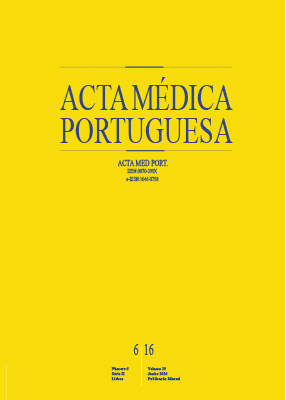HIV/AIDS Indicators for Clinical Care Quality Assessment: Relevance and Utility Assessed by Health Professionals
DOI:
https://doi.org/10.20344/amp.6360Keywords:
Acquired Immunodeficiency Syndrome, HIV Infections, Patient Care, Quality Assurance, Health Care, Quality Indicators, Health Care.Abstract
Introduction: After conducting a systematic review of quality indicators for assessing HIV/AIDS clinical care, we aimed to assess the clinical relevance and practice utility of those indicators from the point of view of HIV/AIDS physician experts.
Material and Methods: This is an observational, cross-sectional study, in which we selected, by convenience, physicians who work in an Infectious Disease Department of a central hospital to complete two questionnaires with a core set of indicators to establish the most relevant and useful indicators for assessment of the clinical HIV/AIDS care. A Likert scale was used to rank the indicators.
Results: Eleven of thirteen physicians filled two questionnaires. From the initial list of 53 quality indicators, 21 were identified as the most relevant and useful in HIV/AIDS clinical care. The internal consistency for clinical relevance in each indicators domain was for clinical signs and symptoms (p = 0.971), for therapy (p = 0.900), for prognosis (p = 0.820) and diagnosis (p = 0.733) and for practice utility were diagnosis (p = 0.934), clinical signs (p = 0.964), laboratory examinations (p = 0.947), therapy (p = 0.583) and prognosis (p = 0.368).
Discussion: In the process of assessing the clinical relevance and practice utility of HIV/AIDS quality care indicators, it was found that the majority of physicians agreed that diagnosis and clinical symptoms and signs indicators domains are the most important for assessing the quality of care for HIV/AIDS patients.
Conclusion: This instrument should be considered as a diagnostic tool, allowing hospital administrators to identify if HIV/AIDS care is properly delivered or needs improvement.
Downloads
Downloads
Published
How to Cite
Issue
Section
License
All the articles published in the AMP are open access and comply with the requirements of funding agencies or academic institutions. The AMP is governed by the terms of the Creative Commons ‘Attribution – Non-Commercial Use - (CC-BY-NC)’ license, regarding the use by third parties.
It is the author’s responsibility to obtain approval for the reproduction of figures, tables, etc. from other publications.
Upon acceptance of an article for publication, the authors will be asked to complete the ICMJE “Copyright Liability and Copyright Sharing Statement “(http://www.actamedicaportuguesa.com/info/AMP-NormasPublicacao.pdf) and the “Declaration of Potential Conflicts of Interest” (http:// www.icmje.org/conflicts-of-interest). An e-mail will be sent to the corresponding author to acknowledge receipt of the manuscript.
After publication, the authors are authorised to make their articles available in repositories of their institutions of origin, as long as they always mention where they were published and according to the Creative Commons license.









